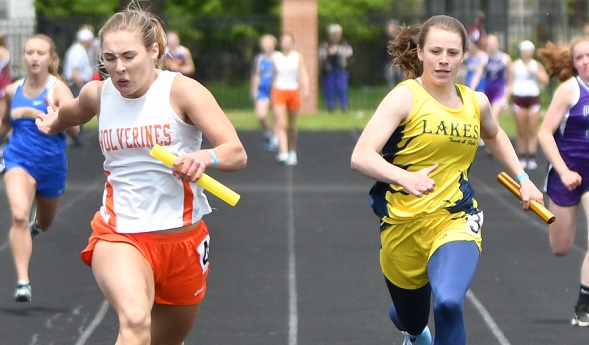
Many Do Their Parts to Drive Lakes 3-Peat
June 1, 2019
By Adam Niemi
Special for Second Half
KINGSFORD – Lake Linden-Hubbell cruised to its third straight MHSAA Division 3 UP Finals championship Saturday.
The Lakes scored 112 points, well ahead of runner-up Felch North Dickinson's 62.
"It's just unbelievable. We knew where we were on paper; we had the most points from our seeding. We know that that never works out," Lake Linden-Hubbell head coach Gary Guisfredi said. "We talked to the girls about how important it was to work for our personal bests, which we got a lot of those today. We also talked about how important it is to, if we're seeded fifth, to get to fourth and bump up. We had that today. We had multiple girls who were not seeded one through six, came out of other heats and actually placed. It really was just an amazing day."
Rock Mid-Peninsula was third (56), followed by Brimley (45) and Stephenson (42) to round out the top five.
The Lakes' third straight title came on the strength of gritty determination and hard work, embodied by Sienna Anderson's comeback from an ACL injury a year ago. She took second in the 100 hurdles behind Brimley's Hayley Gamberdella.
The Lakes took five firsts including wins in the 400 meter and 1,600-meter relays. Mariah Willmer won the 800 run. Jamie Hendrickson won the high jump, and Camaryn Crouch won the pole vault.
Lake Linden-Hubbell's biggest calling card was getting multiple girls piling points in the same event. Three Lakes took the top three places and 24 points in the pole vault, led by Crouch. It was around then that the Lakes padded the lead.
"All of a sudden we went from close, to not so close anymore," Guisfredi said. "I'm just really, really blessed with this group. I'm so happy for them because they've just worked so hard. All the kids work hard, but this has been a fun group."
 Masyn Alexa's big day helped North Dickinson's small team to a runner-up finish.
Masyn Alexa's big day helped North Dickinson's small team to a runner-up finish.
The Nordics sent just six girls to the UP Finals. Lake Linden-Hubbell had 16.
"We really competed well today. Hats off to Lake Linden. They had a great day," North Dickinson head coach Mike Roell said. "We got beat by a really good track team today, but we beat a lot of good track teams to come in second here today. We're really proud of our kids. All year we've been working hard, and it paid off today. I can't say enough. Masyn Alexa broke two school records in the 200 and 400 dashes. She kind of carried us through this thing. We had a lot of young girls that worked their tails off and scraped up enough points to get runner-up. We're really proud of that."
Alexa, a junior, won and set a school record in the 400 with a time of 1:00.86. She held the previous record from last year.
"I've been working to get that record for a long time,” she said. “I ran high 1:01 three different times last year and once again this year. In practice two days ago I was three hundredths of a second away from getting it. I was hoping today I could get it, and I ended up getting it. My coach was at the 200 mark, marking my time as I came across. Then I knew what I was at so I could finish strong.
"I wasn't sure if I had it or not. I knew I was close. I heard all the cheers as I went across. I didn't know whether I had it or not. When I looked, my mom was nodding so I knew I had it."
Alexa also set a new record in the 200, improved by 13 hundredths of a second.
Alexa barely edged Stephenson's Amanda Starzynski to win the 200, by nine hundredths of a second. She was also the fourth leg of the 400 relay that took second behind Lake Linden-Hubbell.
The Nordics also took second in the 800 and 1,600 relays. Hannah Clark placed fourth in the pole vault. Briana Smith was third in the long jump. Skye Ledzian was third in shot put and fifth in discus.
Starzynski leaned forward while crossing the finish line to edge Alexa in the 100 dash by a hundredth of a second. She also anchored the Eagles' 400 relay team that took fifth, and won the long jump.
Baraga's Jaylyn Lindemann won the shot put at 31 feet, 3.5 inches.
PHOTOS: (Top) Rock Mid-Peninsula's Camryn Croadsell, left, and Lake Linden-Hubbell's Joslyn Perala charge toward the finish in the 400 relay. (Middle) North Dickinson's Sophie Mattson runs the 3,200. (Photos by Cara Kamps.)

Track Gaining Speed Toward Future with Electronic Starting Devices
By
Steve Vedder
Special for MHSAA.com
May 23, 2023
Aubrey Greenfield thinks it might be the perfect time to reevaluate 130 years of tradition.
For a number of reasons, from technical to personal, the Oxford senior sprinter believes it makes sense for the crack of a starting pistol to be eliminated from high school track meets.
Because track meets would benefit in various ways from lowering costs to easier setup at meets to the human factor of competitors not having to flinch at the crack of a pistol shot, Greenfield believes the sport has a chance to embrace new technology – electronic starting devices (ESD).
In essence, an ESD replaces the starting pistol with a light flash, tone sound or both to begin a race.
"High school sports should put the athlete first," Greenfield said. "We should promote sports, and eliminating starting pistols promotes health in terms of PTSD or trauma for athletes and spectators and that would be good. I would like to think people would say that's a good idea."
In fact, Greenfield would go as far as to say if there was not an implementation of electronic starting devices, many of her teammates would have considered giving up the sport.
"If it's something that helps us compete safely, we're all for it," she said.
Greenfield's opinion apparently is spreading. Michigan High School Athletic Association senior assistant director Cody Inglis said the use of ESD makes it both affordable for meet starters and sensible for athletes and fans to rethink the use of starting pistols. While the MHSAA is not mandating electronic starting devices, it does promote the use of what Inglis calls "emerging technology." He notes that ESD are becoming the norm for organizations such as USA Track & Field, the NCAA and an increasing number of high schools.
 "I think we have to embrace new technology, and we think this will be something that takes hold," Inglis said.
"I think we have to embrace new technology, and we think this will be something that takes hold," Inglis said.
A key part of embracing ESD is the human element. The tragic Oxford High School shooting Nov. 30, 2021, that took the lives of four students while injuring seven others should not be relived even for a fleeting instance at a high school sporting event. Oxford athletic director Tony DeMare said the school began using ESD at every meet, including the MHSAA Lower Peninsula Division 1 Finals last June. He said that decision was embraced by virtually all schools Oxford encountered.
"We were very convinced that the alternative (of ESD) would promote a healthy attitude," DeMare said. "We were overwhelmed with the positive response. If a school was on the fence about it or might not be for it, I think we've started to see the tide turn in favor of people willing to listen and learn about electronic starting devices."
Inglis said the MHSAA is acutely aware of what the crack of a starting pistol can mean to athletes and fans.
"It's unimaginable what Oxford went through, and this is a small way we can help," he said. "We look at a (starting pistol) and think, ‘Could we do something else?’ It's a way of helping to solve a problem."
Over the last several years, the MHSAA has embraced finding an alternative to starting pistols. Inglis noted the discussion started with the cost and diminishing availability of 32-caliber ammunition that meet starters use. A box of ammunition, if it can be found, is around $75 a box.
In addition to cost, there is potential damage from excessive exposure to 150-plus decibels of sound generated by the traditional 32-caliber blanks. Medical studies show damage to ears caused by decibel levels above 120 dB.
The tragedy at Oxford accelerated the conversation.
Inglis said the cost of ESD can be likened to a school sinking money into artificial surfaces at football fields. Yes, there is a great cost at first, but over time money is ultimately saved. An ESD system itself ranges between $200 and $500. Speakers also may need to be purchased, but with ESD starting events like the 800 and 1,600-meter relays positioned near the outside lanes 8, 7, 6 and 5 would result in improved hearing by athletes at the start of a race.
There is one challenge with ESD that track administrators are working to overcome – lighting conditions that lessen the ability to see the ESD’s LED light or strobe when the button is pressed by a starter to begin a race. But that vision difficulty resulting from clear blue skies and backgrounds of setting suns can be substantially improved by incorporating a black background with an ESD – something as simple as a starter holding up black cardboard behind the lighting mechanism at the start of an event.
Inglis said when all factors are considered, the use of ESD makes sense.
 "With the climate we live in nowadays, no lookalike guns is good," he said. "We're not mandating this. But people are saying this is affordable."
"With the climate we live in nowadays, no lookalike guns is good," he said. "We're not mandating this. But people are saying this is affordable."
While switching to ESD would break 130 years of tradition, the timing could be a step forward, said Jeff Hollobaugh, co-author of the book "The Fleet Feet of Spring: Michigan's High School State Championships in Track & Field." He said while no definitive answer is possible, it's likely starting pistols were used at the inaugural state meet at the Jackson Fairgounds in 1895. The meet, which included events like tossing a 16-pound shot put, bike races and a 100-meter sprint, was sponsored by the Michigan Interscholastic Athletic Association (a predecessor to the MHSAA) and comprised mostly of the state's larger schools.
Hollobaugh's sentiments echo what many involved in today's high school track & field believe in terms of making a transition from starting pistols to electronic starting devices.
"It's a change, not necessarily good or bad, just different," he said. "It's not a drastic change, but it will take some getting used to. But it is the future. In the end, we'll all be fine."
DeMare believes the future of high school track will definitely include ESD.
"Our desire is that the practicality and sensibility of this will overcome the alternative," he said. "I think we'll see the automation and electronics taking hold of certain elements in track, and people will embrace it."
PHOTOS (Top) Runners watch official Bertha Smiley as they prepare to begin a race during last season's Lower Peninsula Division 1 Finals at Rockford. (Middle) An electronic starting device provided by VS Athletics was used to start those races. (Below) Smiley sets to begin an event. (Photos provided by David Kuderka/VS Athletics.)

